|
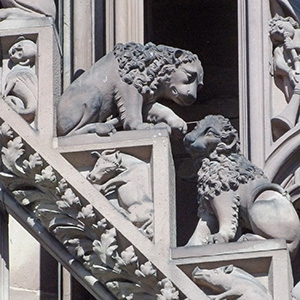 |
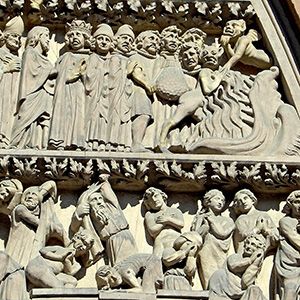 |
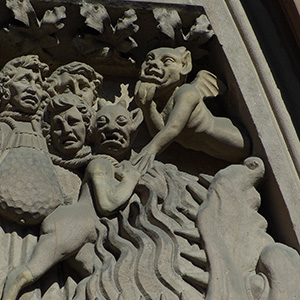 |
|
These lions on the west facade of the cathedral seem cute and playful. However, what is that thing to the left of the top lion? It's face looks like Dobby (the house-elf from the Harry Potter books and films), but it's ears are too small. Human head, wings, front legs of a horse, and the rear is like a fish... that is a winged ichthyocentaur. A fanciful addition to the bulls, boars, and lions over the doors to the cathedral. |
The torments of hell await! This scene, carved in stone upon the cathedral's western facade, reminds me of the Buddhist hell scrolls with their pictures of the torments we are supposedly destined to suffer for our wickedness. |
Here is a closer view of the devil's servants bringing the damned down into the jaws of hell. |
|
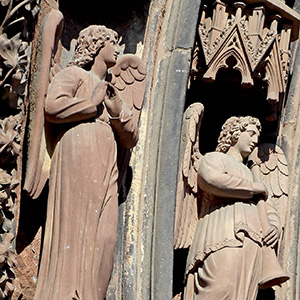 |
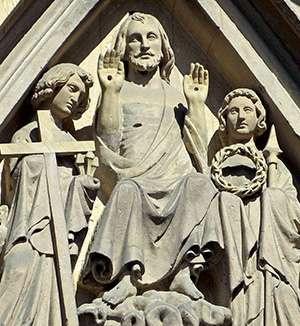 |
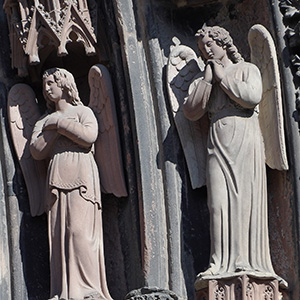 |
|
Angels in poses of adoration. |
"I will know my savior when I come to Him by the marks where the nails have been."
The people who have manifested the spirit of service to others, and self-sacrifice, and suffered or endured hardship through their sacrifice and service, are the the people with the grandest nobility, not necessarily the people who sit in positions of power or enjoy wealth and sophistication. |
Members of the Concourse On High are devoted to the Friend of Humanity (Jesus). |
|
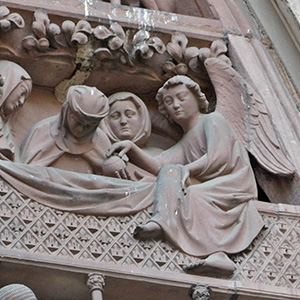 |
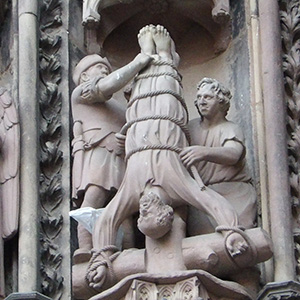 |
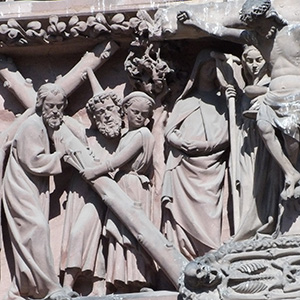 |
|
This vignette on the cathedral shows an angel comforting someone whose head is bowed down, perhaps in prayer or in sorrow. The posture of the angel seems casual and relaxed, not so formal. |
The Roman authorities execute Saint Peter. I wonder how the mechanics of this work, as my understanding is that crucification generally caused death by suffocation and organ failure as the weight of the body made breathing difficult, but how about being crucified upside down? Would Saint Peter have died from blood loss? |
The crucifixion. This is a central moment in the life of Jesus according to the theology that emphasizes sin and redemption, and so this event is emphasized in Christian art. |
|
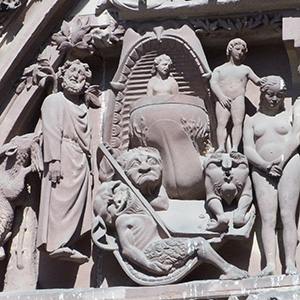 |
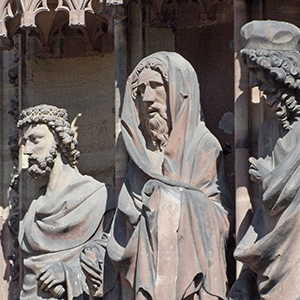 |
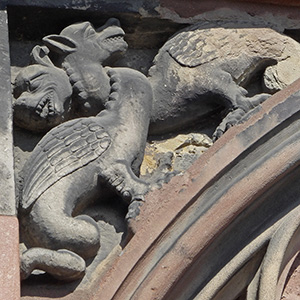 |
|
This is just too strange for me to understand. What is that long thing with a human head and... obscene rear end curled around the cauldron. Is that a tongue supporting the cauldron? The person inside the cauldron looks pretty distressed about being boiled. Is all that taking place in a wide open mouth? What is that thing on the little rocking chair thing on the floor? |
These characters seem to all be holding scrolls. |
These appear to be two cockatrices, although instead of having the heads of cocks, they have the heads of beasts, perhaps of dragons. |
|
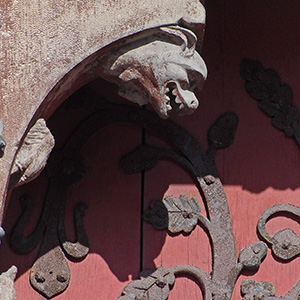 |
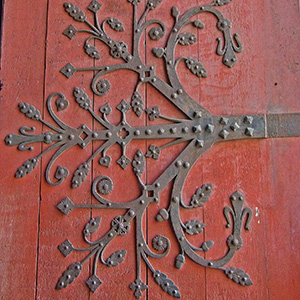 |
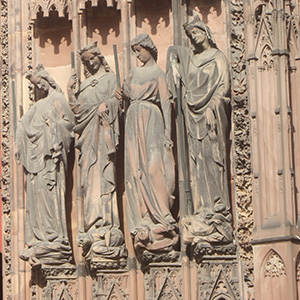 |
|
As you approach the door of the cathedral, even at the threshold of the holy place, vicious or demonic things seem to menace you from above the door. Given the quality of life in the 13th through 15th centuries, the violence and hardship and famine and plague and so forth, I can appreciate the interest in grotesque monsters threatening the people... the abstract threats to physical and spiritual health made into more physical monsters and beasts. |
The ornamental ironwork that strengthens and decorates the cathedral's wooden doors reminds me of the designs generated by graphs of the Mandelbrot set. |
Four human virtues, represented in personified form by these four women, stand triumphant over four vices or sins, represented by the crouching human figures underfoot. |
|
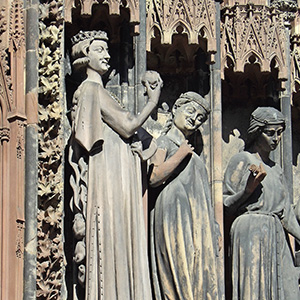 |
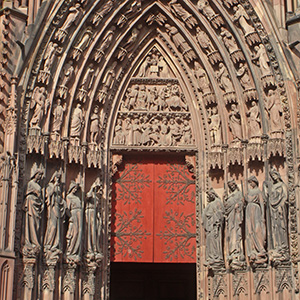 |
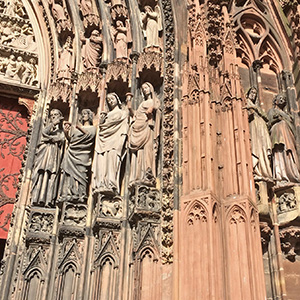 |
|
Here we see Temptation holding an apple. (Temptation is personified here, perhaps the same as evil being personified as the Devil). Two of the "foolish girls" stand nearby, with their cups overturned, because they were careless and allowed the good wine to spill away. Surely this is a deep part of the struggle for humanity, to resist the unconstrained emotional desires, especially the desires for things that aren't good for us, or are harmful to others. Behind Temptation you can see the toads and snakes hidden behind the robe so that the foolish girls can't see. Often the ugliness of our greed is hidden from us, and we don't see how our actions may afflict others with injustice. |
Door on the north side of the western facade of the Strasbourg Cathedral. Visitors usually enter the cathedral through this door. |
These are the wise and virtuous girls, who stand across from the foolish girls. The virtuous girls show their wisdom by holding their cups upright, so they will not spill the wine. |
|
 |
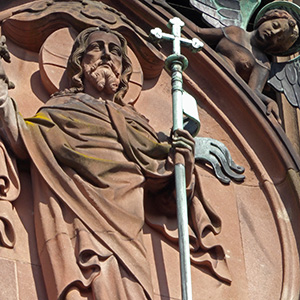 |
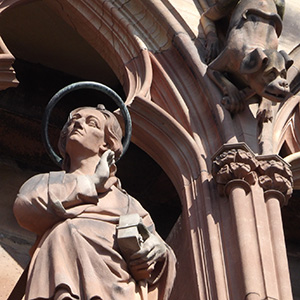 |
|
The Strasbourg cathedral is dedicated to Mary, the mother of Jesus, and she appears in many central places in the architectural decorations of the cathedral. |
Jesus, as a Manifestation of God, stands in a central position in the cathedral decoration, and holds a staff. |
One of the saints on the Row of Saints. |
|
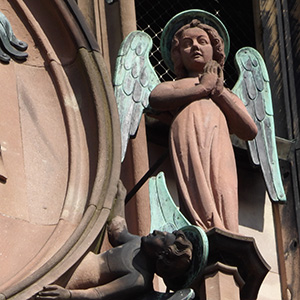 |
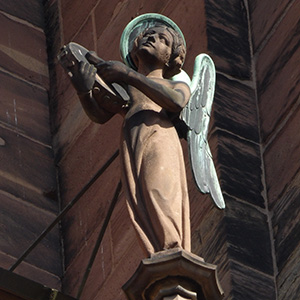 |
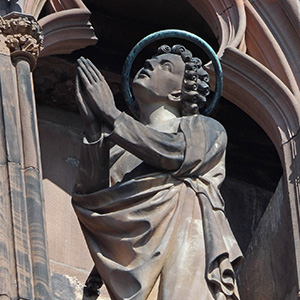 |
|
An angel with hands clasped |
An angel playing a tambourine. |
Another saint on the Row of Saints. |
|
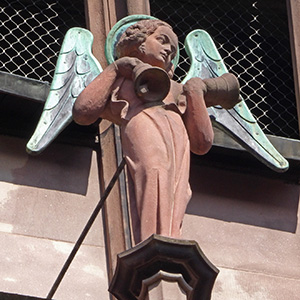 |
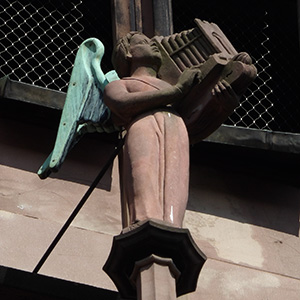 |
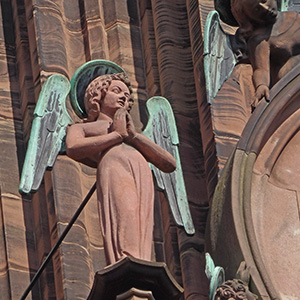 |
|
This angel plays the hand bells. |
It appears that this angel is holding an old-fashioned camera from the 1910s, but I think it's actually holding a hurdy gurdy. |
Another angel with clasped hands. |
|
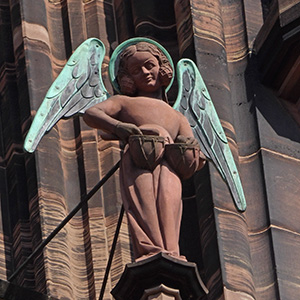 |
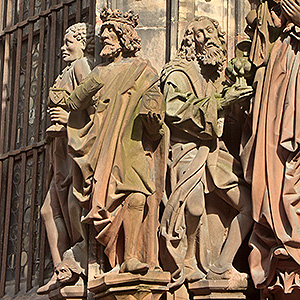 |
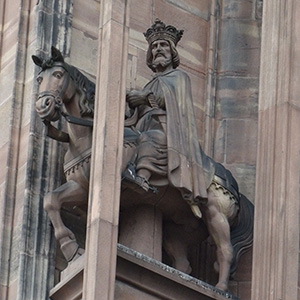 |
|
An angel with a pair of small drums; perhaps bongo drums. |
Important persons represented as statues on the cathedral. |
A king on the cathedral. |
|
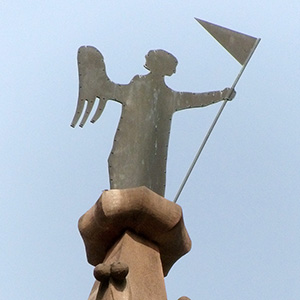 |
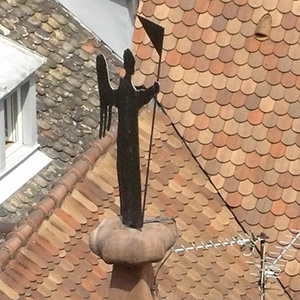 |
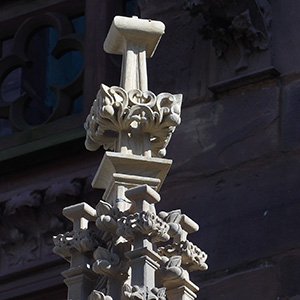 |
|
On one spire, an angel with a pennant. |
Looking down from the spire, angel with the pennant. |
One of the many spires on the Strasbourg cathedral. |
|
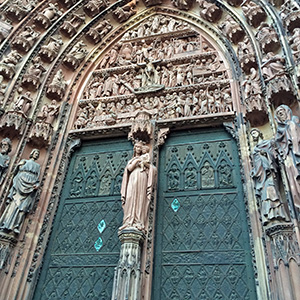 |
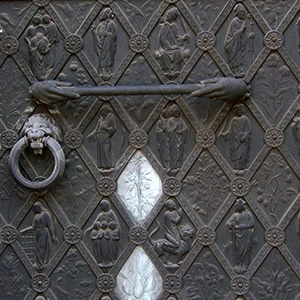 |
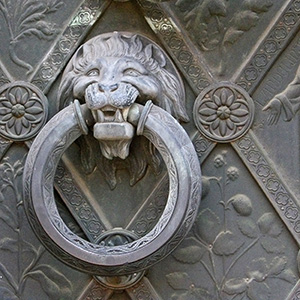 |
|
The central door on the western wall and facade of the cathedral. |
Strasbourg Cathedral's central door on the western facade. |
Strasbourg Cathedral door knocker. |
|
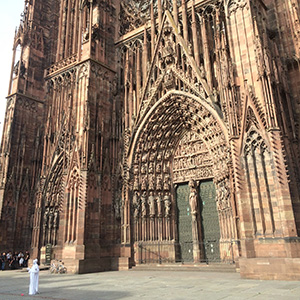 |
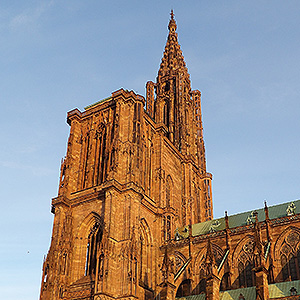 |
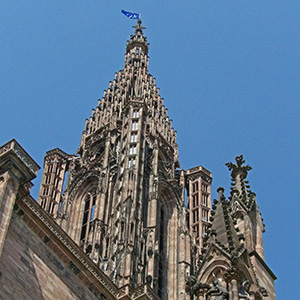 |
|
The central door into the cathedral from the west.
|
The cathedral, looking from the south in the morning light.
|
Looking up at the high spire of Strasbourg Cathedral. From the base of the cathedral to the of of the spire is a height of 142 meters. |
|
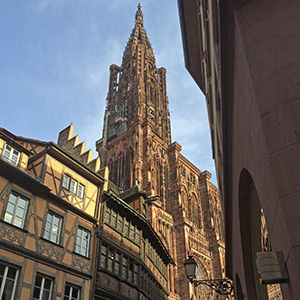 |
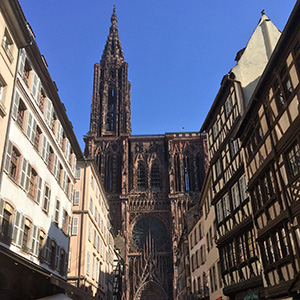 |
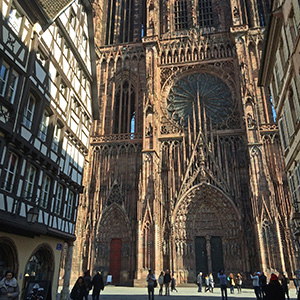 |
|
The cathedral looms up behind the Kammerzell house with afternoon light illuminating the western facade. |
The cathedral, a view of it as one approaches down the Rue Merciere. |
The western facade of the cathedral from the east end of Rue Merciere. |
|
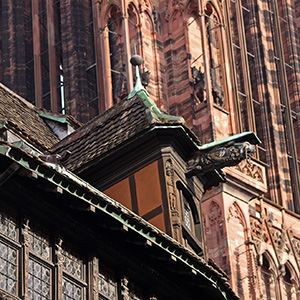 |
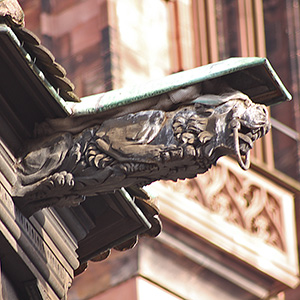 |
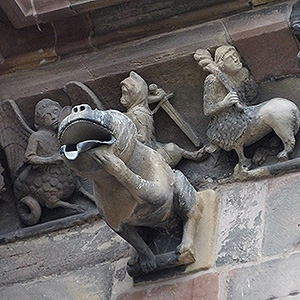 |
|
The Kammerzell building, last major renovation in 1589, but the house dates to 1427. It stands on the Cathedral plaza, and in this photo of the top floor and roof, you can see the cathedral in the background. |
A closer look at some decorative element on the Kammerzell House. |
Strange things to see on the cathedral. The artists who created such figures in the 13th through 15th centuries as the cathedral was constructed had active imaginations. |
|
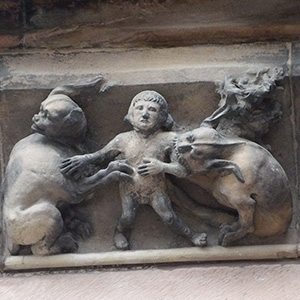 |
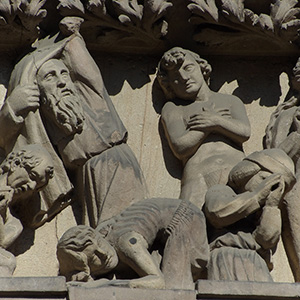 |
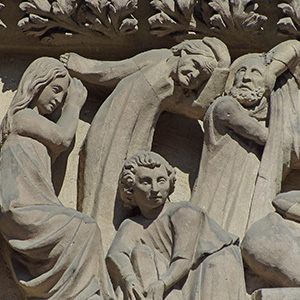 |
|
Is this a scene of an evil person being devoured by monsters, or did the people who made and witnessed this sort of image understand the "person" to be a personification of certain wicked tendencies or a particular facet of a person, destined to be destroyed? |
The trumpets have sounded, and people face judgment. It seems they fear for their futures. |
People prepare for final judgment. They seem to be worried about how they will be judged. |
|
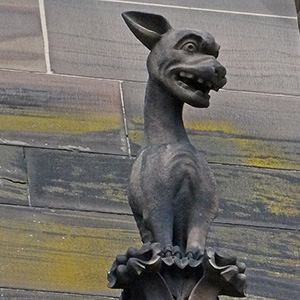 |
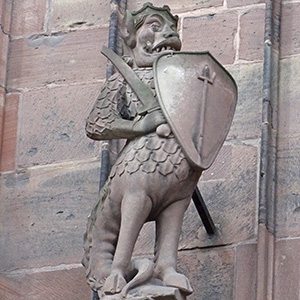 |
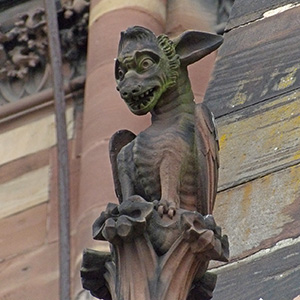 |
|
It is difficult to know whether the statues decorating the cathedral date back to the 13th or 14th or 15th centuries, or whether they are modern replacements installed in the late 19th or early 20th centuries, but it doesn't really matter; even the modern works replacing the original ancient statues (the ancient statues are preserved in museums and archives) closely follow the original designs and appearances. |
I am not even sure what sort of a monster this is. If those are horse legs, and the tail represents a fish tail, then this is some sort of ichthyocentaur. |
This strange beast is just one of the many unusual creatures populating the exterior of the Strasbourg cathedral. |
|
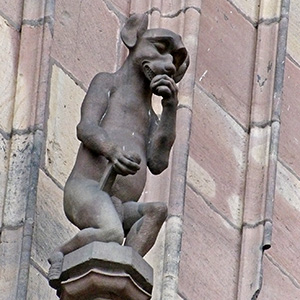 |
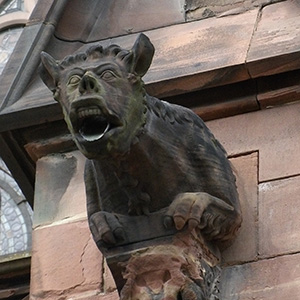 |
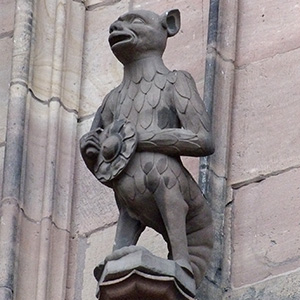 |
|
This creatures seems to be a dog-headed man. I wonder what is so funny, as this figure is clearly laughing. |
Some of the gargoyles and water spouts on these old cathedrals, such as the Strasbourg cathedral, convincingly mix human and animal attributes. |
This may be another ichthyocentaur (usually with the head and torso of a human, legs and mid-body of a horse, and tail and rear body of a fish). The head seems mostly human with some strong fish characteristics. |
|
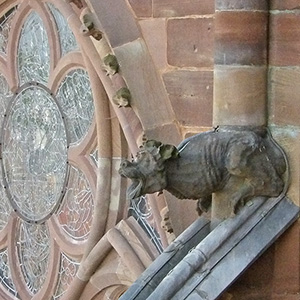 |
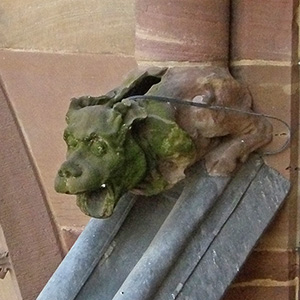 |
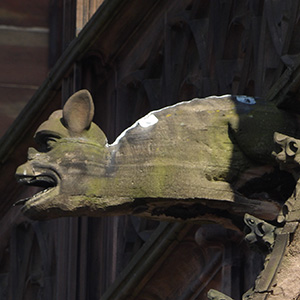 |
|
The stained glass windows, which are so lovely from the inside of the church, are far less colorful from outside. This photograph also shows a water-spout decorative beast. |
This water spout beast seems to be cracking and deteriorating, and some sot of moss or green fungus is adding color to the head, further accentuating the grotesque aspects of this element. |
The erosion on this particular element on the cathedral suggests it may date back to the 13th century, when much of the cathedral was constructed. |
|
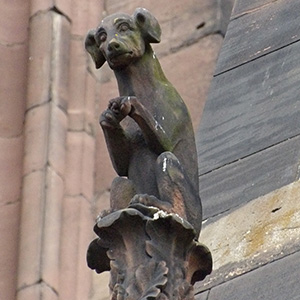 |
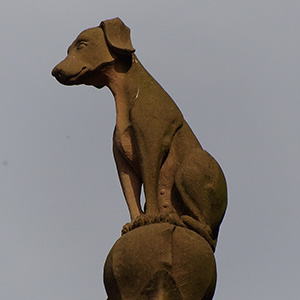 |
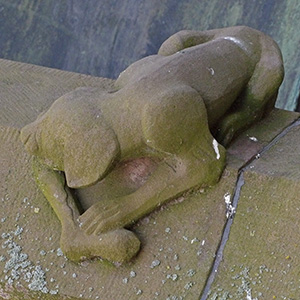 |
|
The Strasbourg cathedral has many dogs in prominent places of its exterior decoration. The loving loyalty of dogs may have been an inspiration to the artists who made the cathedral. |
One of the many dogs on the cathedral's exterior. Perhaps this is a 20th century replacement of a much older original canine statue. Strasbourg Cathedral has had many 13th and 14th century dog statues on it. |
This dog on the cathedral is positioned on the roof so that a visitor can only get a good view of it while looking out of windows in the tower, as it would be nearly impossible to see it from the ground. |
|
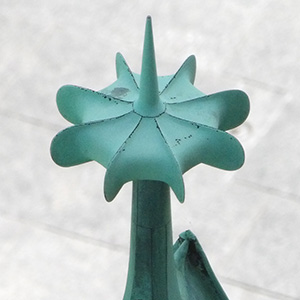 |
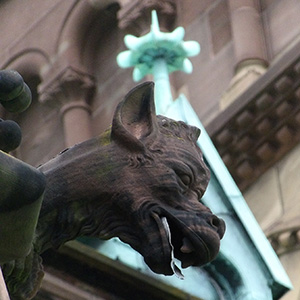 |
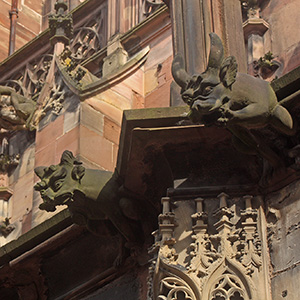 |
|
Tip of a decorative spire adorning the cathedral roof. |
This strange head, with details in the skin texture of the carving, looking down from the cathedral roof, seems to threaten away any intruders who would approach the cathedral with impure thoughts. |
These little monsters on the cathedral wall seem too cute to be threatening. |
|
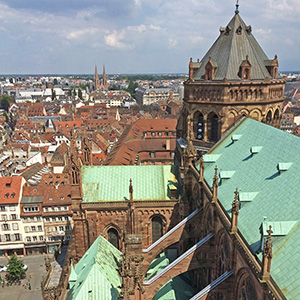 |
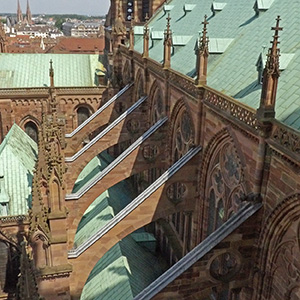 |
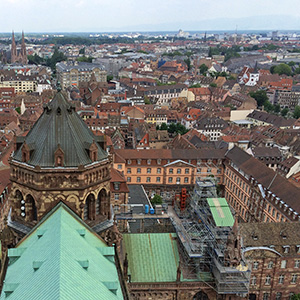 |
|
This is a view looking east over the north side of the cathedral, from the north (highest) tower. The twin spires in the distance are the German Lutheran cathedral constructed when Strasbourg was (briefly) restored to German political control during the 1871-1918 period. |
This view of the north side of the nave gives an opportunity to study the flying buttresses supporting the weight of the nave, which allow the nave's wall to have huge windows. |
Looking east over the nave, one can admire the lantern tower, built over the transept. The present tower is a restoration made after heavy damage in the Second World War to a 1878 tower, but old illustrations of the cathedral show that the medieval tower over the transept looked very similar. |
|
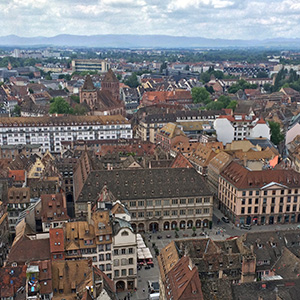 |
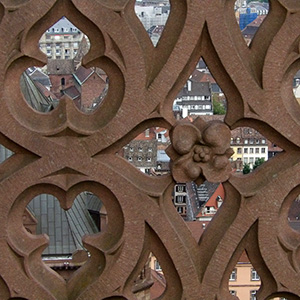 |
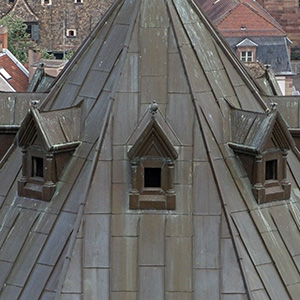 |
|
Looking west from the towers of the cathedral one can see the Vosges mountains in the distance beyond the town of Strasbourg. |
Some of the Gothic stone screen around the observation platform on the southern tower. |
A close view of the windows on the lantern tower. |
|
History Timeline
Sources and diversions.
|
Other web pages with our pictures:
2015 collection of images from Europe
- Page 1, London.
- Page 2, Castille: Madrid
- Page 3, Strasbourg in March.
- Page 4, Strasbourg in April.
- Page 5, Strasbourg in May.
- Page 6, Paris.
- Page 7, The interior of the Notre Dame Cathedral in Strasbourg.
- This is page 8, The exterior Strasbourg Cathedral in Strasbourg.
- Page 9, Turkey: Edirne and Istanbul.
- Page 10, Austria: Salzburg.
- Page 11, Switzerland: Basel, Gimmelwald, & the Alps.
- Page 12, France: Alsace and Lorraine (Nancy, Colmar, Riquewihr, Haut-Koenigsbourg, Obernai, Molsheim, Nideck, Haguenau)
- Page 13, France and Monaco (Nice, Saint-Jean-Cap-Ferrat, Montpellier, Monte Carlo)
- Page 14, Germany: Bavaria (Füssen, Hohenschwangau, Munich)
- Page 15, Germany along the Rhine (Rastatt, Karlsruhe, Bruchsal, the Rhineland-Palatinate)
- Page 16, Bulgaria (Varna, Plovdiv, Kazanlak)
- Page 17, Romania (Brasov, Bran, Sinaia, Sighisoara, Biertan, Sibiu, Bucharest)
- Page 18, Luxembourg and Arlon, Belgium
- Page 19, Italy and San Marino (Milan, Genoa, Bologna, Rimini, Citta di San Marino)
- Page 20, Catalan: Barcelona
- Page 21, Netherlands: Amsterdam
- Page 22, Denmark: Copenhagen
Thematic Pages
- Page 1, Doors (1): Doors and portals.
- Page 2, Doors (2): More doors, portals, and gateways.
- Page 3, Doors (3): More gates, doors, portals, and entrances.
- Page 4, Doors (4): Even more doors.
- Page 5, Door Fixtures (1): Decorations and fixtures on doors; door knockers or door knobs.
- Page 6, Door Fixtures (2): More door handles, door knobs, knockers, and so forth.
- Page 7, Door Fixtures (3): Another page of door fixtures such as door knobs.
- Page 8, Lamps and Lights (1): Lanterns and lamps, with several from Romania.
- Page 9, Lamps and Lights (2): Lanterns and lamps, including San Marino and Barcelona.
- Page 10, Lamps and Lights (3): More lanterns and lamps.
- Page 11, Lamps and Lights (4): Even more lights, lanterns, lamps, and so forth.
- Page 12, Flowers, Tulips (1): Keukenhof Garden and its tulips..
- Page 13, Flowers, Tulips (2): Second page of flowers, more tulips in Keukenhof Garden.
- Page 14, Flowers, Tulips (3): More tulips.
- Page 15, Flowers, Orchids (1): Flowers, mostly orchids.
- Page 16, Flowers, Orchids (2): Orchids and similar flowers.
- Page 17, Flowers, Orchids (3): Even more orchids.
- Page 18, Flowers and Plants (1): Various plants, including flowers and trees.
- Page 19, Flowers and Plants (2): Flowers and interesting plants, including mushrooms.
- Page 20, Flowers and Plants (3): Trees, flowers,ferns, and interesting plants.
- Page 21, Spires and Weathervanes (1): Weather vanes and decorative spires on top of roofs.
- Page 22, Spires and Weathervanes (2): More weathervanes, spires, and so forth.
- Page 23, Spires and Weathervanes (3): Even more decorative spires and weathervanes.
- Page 24, Shop Signs and Ornamental Ironwork (1): Fences, gates, shop signs, and so forth.
- Page 25, Shop Signs and Ornamental Ironwork (2): More shop signs and ornamental iron.
- Page 26, Domes (1): Views of round roofs and cupolas, including large domes.
- Page 27, Domes (2): Views of domes and cupolas, including some spires, interior and exterior.
- Page 28, Windows (1): A page of interesting windows.
- Page 29, Windows (2): Another page showing windows.
- Page 30, Windows (3): A page of windows, mostly stained glass windows.
- Page 31, Windows (4): More windows.
- Page 32, Jewels and Ornaments (1): Jewels and ornaments.
- Page 33, Jewels and Ornaments (2): More jewels and ornaments and decorative things.
- Page 34, Statues (1): A page full of picture of statues and sculptures.
- Page 35, Statues (2): More statues and sculptures.
- Page 36, Water features and water (1): Pools, ponds, lakes, rivers, waterfalls, and so forth.
- Page 37, Water features and water (2): Beaches, lakes, rivers, cascades, and so forth.
- Page 38, Faucets, Fountains, and Spigots (1): Mostly fountains.
- Page 39, Faucets, Fountains, and Spigots (2): Fountains and spigots or faucets.
- Page 40, Furniture (1): A page of interesting furniture.
- Page 41, Furniture (2): More examples of interesting furniture.
- Page 42, Palaces (1): A page with photos of palaces.
- Page 43, Palaces (2): More palaces.
- Page 44, Animals and zoos (1): Pictures of animals and scenes in zoos.
- Page 45, Animals and zoos (2): More images of animals and zoos.
|
|
|
|
|
|
|




































































